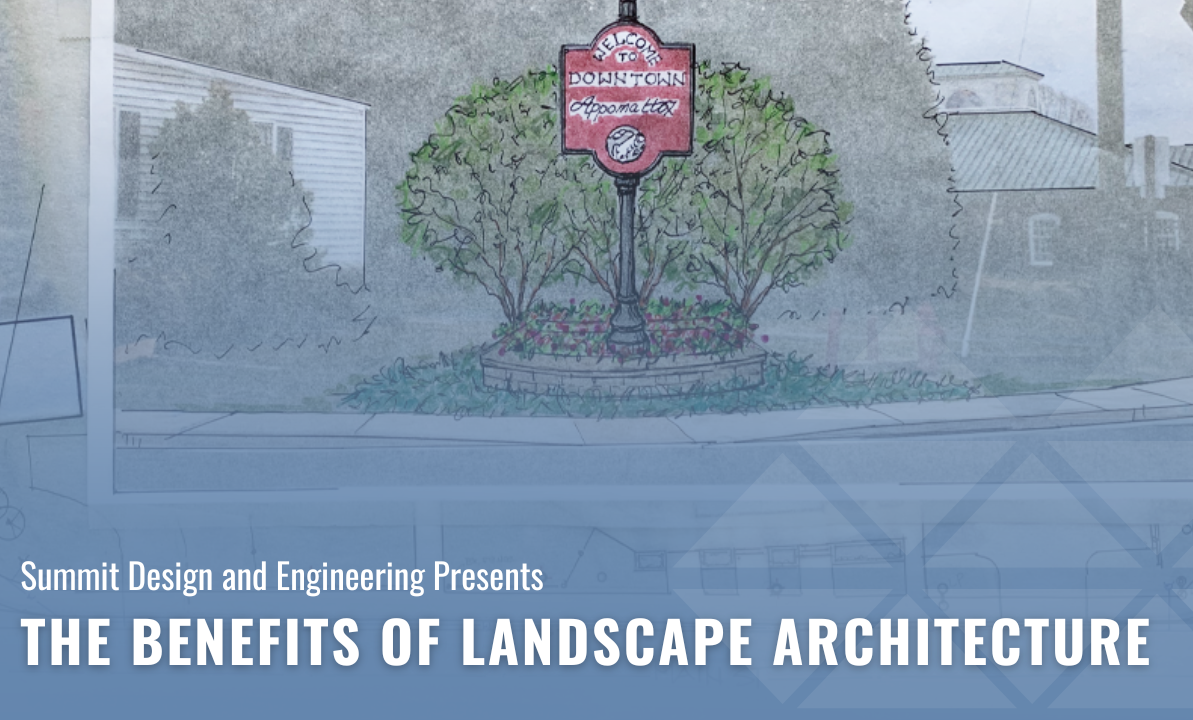Landscape Architecture is in practice all around you, every day.
A historical field that has been around for centuries, landscape architecture is responsible for numerous famous locales, such as the Miller Garden in Indiana, the Vaux le Vicomte in France, and even Central Park in New York City! With such fabulous sceneries under its belt, it would go to reason that the benefits of landscape architecture are many– not the least of which is the beauty it works into projects and places worldwide.
Summit’s own landscape architecture department is small, but that doesn’t mean it isn’t mighty! Like other design departments worldwide, our firm works hard to deliver a cohesive, holistic project to our clients. Landscape architecture is an integral part of this experience. From enhancing a location’s visual appeal to improving communities’ health and well-being, today’s blog will explore the many advantages this important design field brings to our everyday lives.
What is Landscape Architecture?
Landscape Architecture is a key civil design service within our firm, but the field itself can be a little obscure. When many people think of architecture, they often think of significant, interesting buildings with unique designs. Architecture is known for its unique stylistic influences and how it serves communities and cultures through design.
The very same can be said of landscape architecture! Though many people mistake it for gardening or land stewardship, landscape architecture is much more complex. In short, it is a profession involving the planning, design, management, and cultivation of natural environments that complement the built environment.
If you’re unfamiliar with architecture, you may wonder– what is the built environment? That would be anything human-made. Buildings, bridges, transportation—even farmlands count as the built environment! That’s because we cultivate farmlands to service human needs, which means they are not naturally occurring.
Conversely, the natural environment is what occurs naturally in the world around us, like bodies of water, soils, rocks, native wildlife, and other natural resources. Landscape architecture uses art, design, and science to blend these natural features with the built environment.
Landscape architecture projects can be a nature trail, a public garden, or working with a city to develop a communal greenspace. These projects can also be collaborations with existing recreational spaces like playgrounds and golf courses to make them more ecologically friendly, functional, and beautiful. You can see landscape architects’ influence in shopping malls, museums, schools, and universities, where their work extends past site design and into master planning. Overall, their services are important to nearly every civil design project.
There are endless applications for landscape architecture, especially as we move towards building a cleaner, greener future alongside nature.
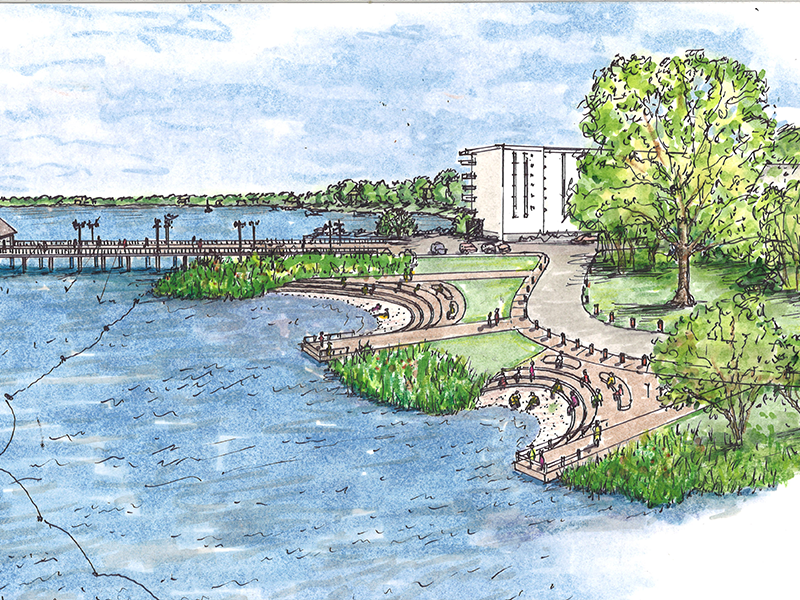
Re-imaging of the Tappahannock Pier over the Rappahannock River for the Town of Tappahannock Downtown Revitalization project.
The Benefits of Landscape Architecture
Though the profession of Landscape Architecture has been around since the 1800’s, it is becoming a more important part of the built and natural environments as we see increases in natural disasters and losses of biodiversity. Research has shown that designing with natural systems can yield more resilient communities, which are better prepared for flooding events and quicker to recover. Not to mention the increasing body of research which points to the mental health benefits of people connected with nature, especially those living in a highly urbanized environment.
Below are seven key benefits that landscape architecture brings to our communities.
Health Benefits of Landscape Architecture
It Connects People to Nature
Research shows that spending even a small amount of time in nature daily improves happiness and mood. Engaging in opportunities to be outside can help improve people’s physical and mental health, including cognitive function, brain activity, blood pressure regulation, and disordered sleeping. However, it can be difficult to connect with nature and reap its many benefits when you live in urban environments where greenery can be sparse.
This is where landscape architects come into play. Most city planning accounts for including trees, shrubbery, and other small tokens of nature in their master plans by design. However, landscape architects can move beyond this by helping to design cohesive green spaces that emulate being in nature. By combining the natural world with our built environment, landscape architects deliver places where we can walk among natural features that cultivate a connection to the environment.
Introducing green spaces to urban and suburban environments can be done overtly with parks, gardens, and nature walks. It can also be done hand-in-hand with other development and redevelopment of spaces that may have been lacking greenery before, creating communal gathering areas and mixed-use spaces that utilize foliage to create shade, provide barriers between businesses, and draw visitors.
Take, for instance, the SECU Midtown Market project the Summit landscape architecture team worked on. By designing a nature trail on-site, the landscape architects were able to utilize the natural features of the property to bring the community a new, functional, and sustainable space. The nature trail included benches to allow visitors to sit and overlook a ravine behind the building, providing space for employees, customers, and nearby residents to enjoy the outdoors.
Beyond connecting people with nature, we seek to promote equitable pedestrian access and create beautiful spaces which tie in to the cultural, historical, and ecological significance of the surrounding locale. All these factors are taken to the table when landscape architects work with clients- public or private. An often-overlooked part of our work is educating clients on why those factors are important.
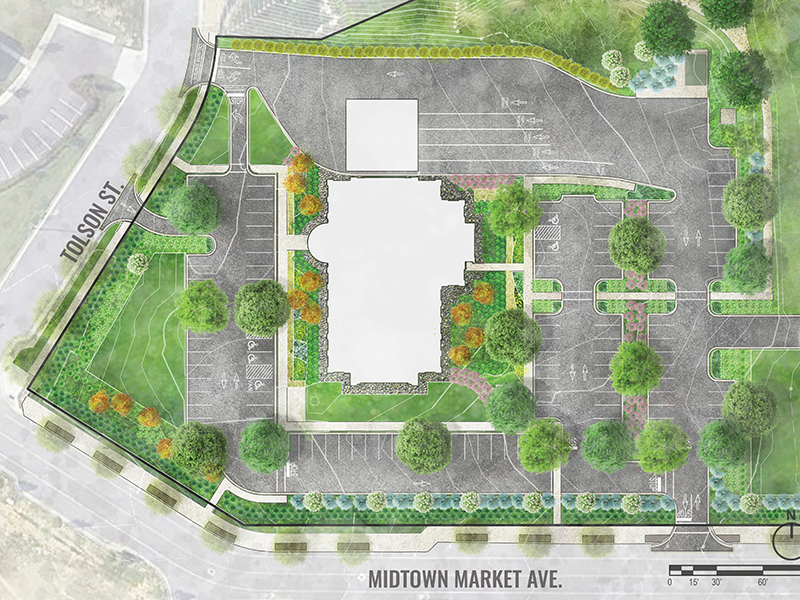
SECU Midtown Market Concept Layout
It Increases Air Quality
The health benefits don’t end with simple exposure to nature. After all, it’s no secret that plants are one of—if not the most—vital component of combating air pollution. By pulling pollutants out of the air, the trees, shrubs, and bushes around us reduce air temperature and emissions. Landscape architects put plants to use in all manner of projects, ensuring that they increase the overall greenery of cities, towns, suburbs, and more.
The National Recreation and Park Association conducted a study that found that urban greenery in the US removes about 75,000 tons of airborne pollutants, or about 80 pounds, per acre of tree coverage. Annually, they estimate that carbon removal from trees alone amounts to 2.4 million tons. That’s a lot of fresh air!
On a local scale, though, these effects are still quite evident. Urban greenery provides communities with numerous health benefits by removing pollution from the air. Consistent exposure to clean air reduces early mortality and the prevalence of many health concerns, such as bronchitis, asthma, myocardial infarctions, and even cancer.
Research shows that utilizing native soil and vegetation in designing green spaces can even influence the airborne microbiology of the environment. This means that landscape architecture has the potential to benefit human health on a microbial level by designing neighborhoods and spaces that help bacterial biodiversity!
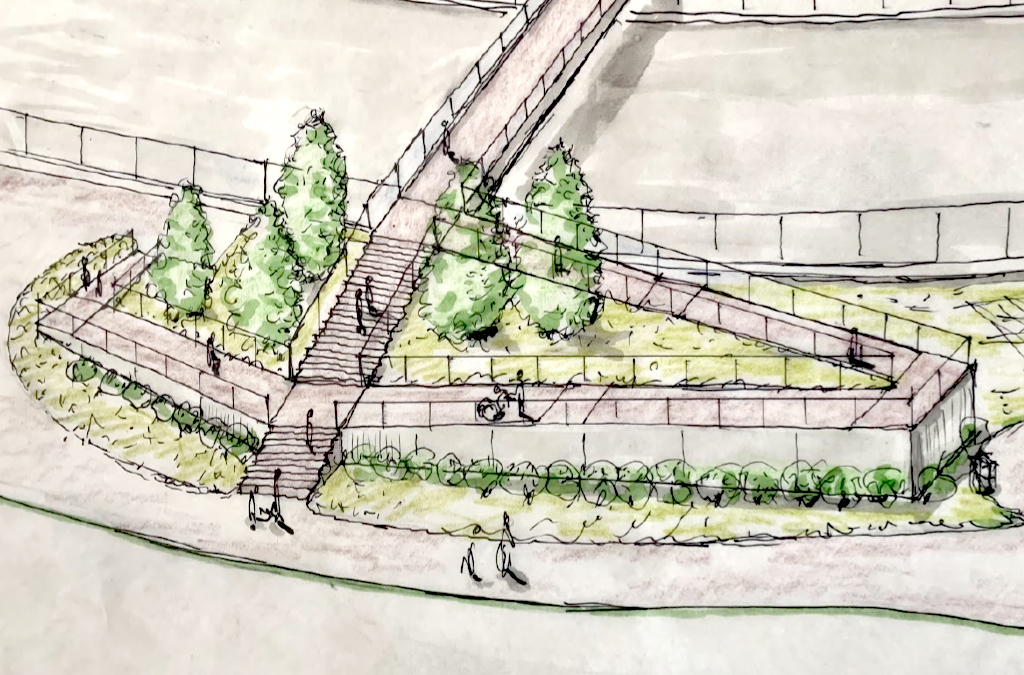
Carrier Park Bridge Concept Sketch
Community Benefits of Landscape Architecture
It Satisfies our Need for Aesthetics
Aesthetics are a crucial part of how we perceive the world. They affect how we feel about things, perceive them, and even remember them later. Though every individual has their own preferences, appealing to our innate sense of beauty is one way to ensure that a project will stand out and be remembered. After all, research shows that the appearance of our environment significantly impacts our happiness. To put it simply—aesthetics are critical to human moods.
Landscape architecture is the perfect way to build on this desire for aesthetically pleasing spaces. By appealing to aesthetics, landscape architects can influence how an individual may feel about a location. They can conjure up a sense of importance or grandeur, such as in greenery fixtures outside of important government buildings, or they can impart a sense of peace and happiness, like with gardens. They can even help us feel more connected to our culture and history or leave us feeling nostalgic for another time and place.
The psychology behind aesthetics can go even deeper, however. When people feel connected to their environment, they often feel a sense of ownership or stewardship. The desire to experience beautiful and comforting spaces can often inspire a community to unite to maintain the space. The effect is two-fold: individuals become closer through stewardship events, such as litter pickup days and volunteer work, and the space benefits from active use and interest. This leads to other benefits, such as “placemaking” and functional spaces.
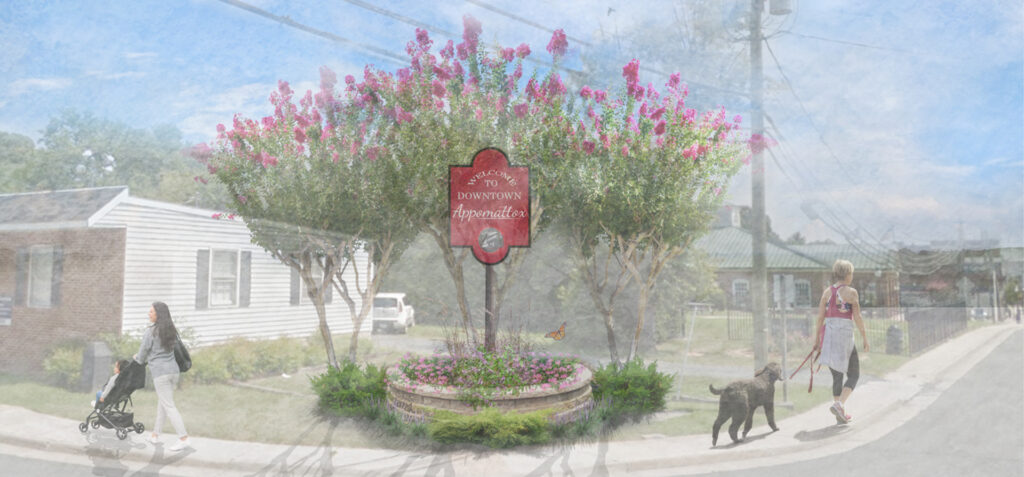
Concept Rendering for the Town of Appomattox Downtown Revitalization
“Placemaking” and Functional Spaces
Landscape architects aren’t only concerned with aesthetics. They also work hard to ensure that the spaces they design can serve many purposes, both recreationally and economically. One of the key benefits of landscape architecture in a community is that it can create a sense of place—or, more specifically, it’s vital to placemaking.
What is placemaking? This concept, which has seen growing traction in design circles over the years, dates back to the 1960s. The core of the ideology is this: what if we designed our built environment to be catered to the people it’s meant to serve? This is a community-and-people-first way of thinking that considers the population’s local culture, concerns, and desires. Placemaking, according to the Project for Public Spaces, is “an overarching idea and a hands-on approach for improving a neighborhood, city, or region [. . . and] inspires people to collectively reimagine and reinvent public spaces as the heart of every community.”
People want to feel connected to their communities. A study conducted on over 43,000 people over three years concluded that one of the primary desires of most people was social offerings. This includes events, community amenities, and places to spend time outside of home and work.
So, what does this have to do with landscape architecture? Landscape architecture fills the void created by the lack of ‘places’ by providing spaces where social offerings can be fulfilled. Terraced gardens that also serve as café seating, outdoor arenas that can host live entertainment, and recreational amenities that make use of natural features all contribute to a sense of community and place. All of these have economic incentives, too, because…
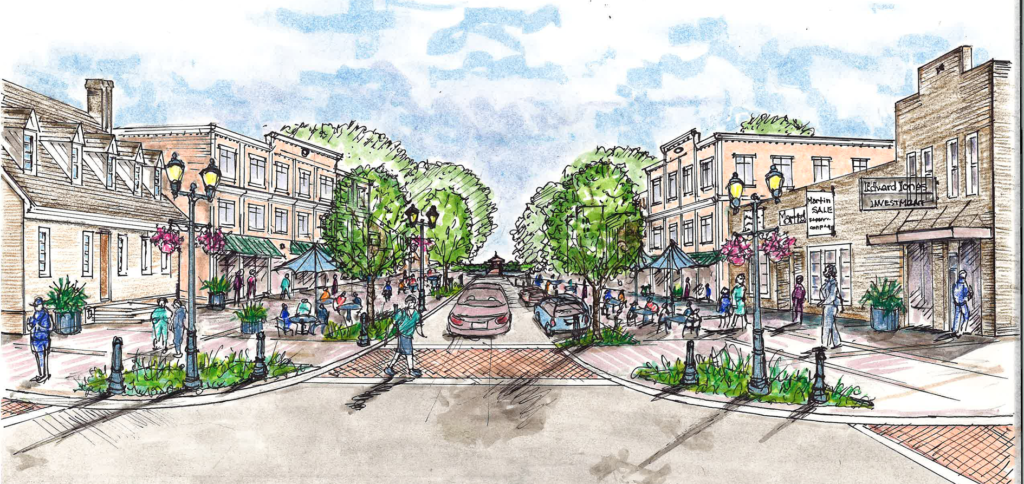
Illustration of Prince Street renovation recommendations for the Town of Tappahannock Downtown Revitalization. The concept image here is meant to invoke placemaking and economic revitalization, with Landscape Architecture’s help.
Landscape Architecture Contributes to Economic Growth
You may be tempted to remain in the area for a while when you’re presented with a street with ample greenery, shade, and seating. That’s because people are attracted to places where their comfort is catered to, and if that place is also functional, they are likely to spend a lot of time there. The more appealing a location, the more likely people are to spend money and return repeatedly. Landscape architecture is integral to revitalizing the economic landscape of towns and cities by creating these appealing spaces.
The economic benefit goes beyond the incentive to spend time outdoors, however. The impact that a nearby park or ecological feature has on the value of property nearby is a known phenomenon: The Proximate Principle. According to Texas A&M University, “Residences located close to urban parks frequently sell at a premium. The increased home values represent a ‘capitalization’ of a park’s value to proximate homeowner.” In layman’s terms: people want to be close to natural beauty (such that is represented in parks) and therefore will pay more to experience it.
Public features that landscape architects work on draw benefits in other ways. Tourists will patronize a beautiful park or garden. Business owners alongside a new trail will likely see an increase in revenue. By building resilient, functional spaces that people out of their homes, landscape architects provide communities with the best of both worlds: a space that benefits both consumers and businesses.

Queen Street reimaging sketch as part of the Tappahannock Downtown Revitalization project.
Environmental Benefits of Landscape Architecture
It Promotes Environmental Sustainability
Landscape Architects play an essential role in shaping our environment. That puts them in a unique position of responsibility to the environment. Designing sustainable, resilient, and ecologically friendly spaces is one of the most important jobs a landscape architect can have when working on a project.
Incorporating environmentally friendly practices into designing a space can look like choosing recycled or low-impact materials (often locally sourced), choosing energy-efficient alternatives to standard manufacturing processes, and using highly durable, resilient materials to lengthen the usable lifespan of the project.
Landscape architects are also known for prioritizing native flora and fauna in their work. By utilizing native soils, trees, and grasses, landscape architects not only participate in preserving local ecology but contribute to surrounding ecosystems. For example, by encouraging a municipality to plant native trees with long lifespans in a park, landscape architects encourage local wildlife who depend on these trees to remain in the area.
Finally, landscape architects are vital to maintaining the preservation of surrounding environments. This is especially true of fragile and complex environments, such as wetlands, which require special consideration. When working on projects, landscape architects can make key suggestions and recommendations that will help to preserve the native biodiversity of these locations and mitigate any negative impact a built environment may have, such as through increased stormwater runoff.
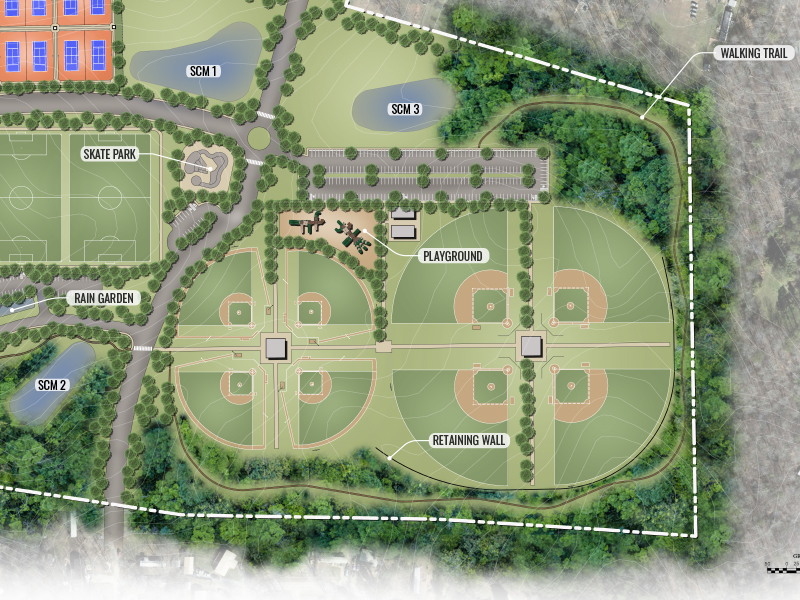
Concept Rendering for the Meadowmont Farms Due Diligence Study
It Combats Stormwater Runoff and Flooding
One of the primary concerns when working on a project is stormwater management. When heavy rainfall affects an area, it can cause all kinds of local disasters, such as polluting the freshwater supply, endangering local ecosystems, and causing dangerous and costly floods. With the effects of climate change becoming more and more prevalent with each passing season, it’s more pressing than ever to approach the development or our land and environment with damage mitigation in mind.
Landscape Architecture plays a crucial role in developing these mitigation methods. Harnessing modern strategies like permeable pavements, retention basins, and water-retaining soil, landscape architects slow down stormwater drainage and filter out harmful pollutants. Using natural plants and trees in the design of public spaces can also result in a ‘barrier’ that captures, absorbs, and filters stormwater, thus reducing the risk of flooding.
Some landscape architects are even able to utilize captured stormwater as an asset using cisterns and water barrels! The captured water can be treated and used for irrigation, thus reducing the freshwater impact a design might have on the municipality.
Having landscape architects as part of a project from the beginning ensures that these environmental hazards are not only accounted for, but are addressed in a functional and pleasing manner that caters to the vision of the project.
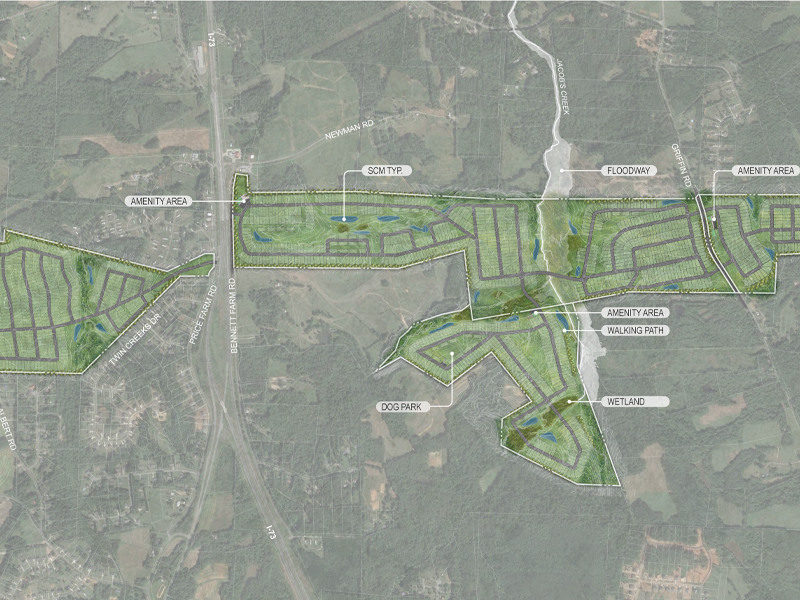
Concept Rendering for Bennet Farms Due Diligence Study
Landscape Architecture at Summit Design and Engineering
At Summit, our Landscape Architecture has over 90+ years of combined experience when it comes to designing, planning, and managing outdoor spaces. In our effort to deliver functional and beautiful projects, our team has provided design services for parks, municipal areas, outdoor accessibility features, master plans, and feasibility studies. Our work can be broad, such as master planning a community, or more intimate, such as detailing a parklet. Many of the communities we work in are the ones our Summit coworkers call home!
Though our department is small, the work we do is both impressive and integral to our firm, where we work closely with civil to design the exteriors of buildings. Our focus is on preserving the natural environment with all projects; we prioritize human and environmental health as we design beautiful spaces, seek out opportunities to connect people with nature, and promote ways to make communities more resilient through design. Our team also applies a firm understanding of how people interact with their surroundings to their designs, in turn creating spaces that are both aesthetically pleasing and practical.
Meet the Team!

Nik Nikolaev – Nik has worked on numerous urban projects throughout the East Coast of the United States. He has provided multiple master plans for higher education, commercial developments, and municipal clients over his career. Nik has also worked on numerous greenways and multi-use trails in communities all over Eastern US.

Bob Kopetsky – Bob’s landscape architecture portfolio is shaped by enhancements to corridors and gateways as well as environmental mitigation projects on streets and roadways throughout North Carolina. He works shoulder to shoulder with roadway engineers looking for solutions that bring context, safety, environmental sensitivity, and community interests to the forefront.

Jim Ashley – With over 25 years of experience, Jim’s portfolio includes park design, park and recreational master planning, research and development design, PARTF grants, residential and mixed-use developments, and more. He actively seeks ways to assist the communities by creating environments where everyone can thrive.

Charlotte Kennedy – Charlotte’s experience with environmental site analysis, conceptual design, graphic communication, and sustainable practices makes her an asset to the team. As a certified SITES Accredited Professional, Charlotte offers an understanding of sustainable design in terms of plant selection, hardscape materials, construction practices, green stormwater capture and treatment, and long-term site management.
Conclusion
Recognizing the impact of our built environment on the natural environment of our world cannot be overstated. Fortunately, we have landscape architects who can address the environmental, economic, and community needs—all while working towards creating a more beautiful, livable world. Through the incorporation of sustainable practices and thoughtful design, landscape architects bring numerous benefits to every project they work on, ensuring that our spaces continue to be beautiful, functional, and resilient.
If you would like to learn more about Summit Design and Engineering’s landscape architecture department, check out our service page or read more about our featured project, the Carrier Park Pedestrian Bridge Feasibility Study!
Thank you to Charlotte Kennedy for assistance on this blog.
